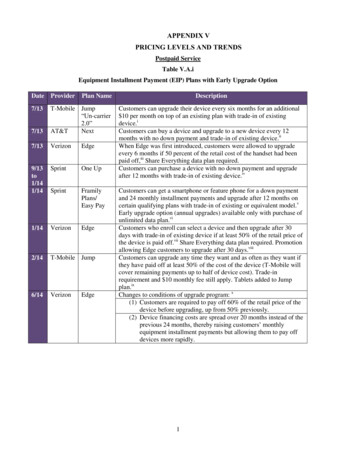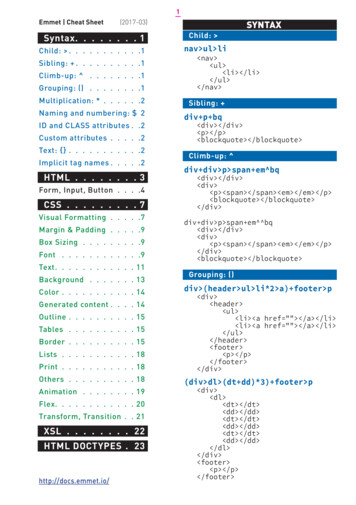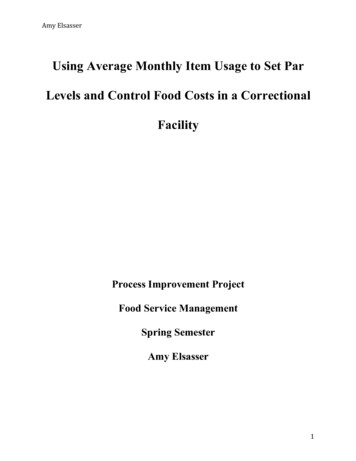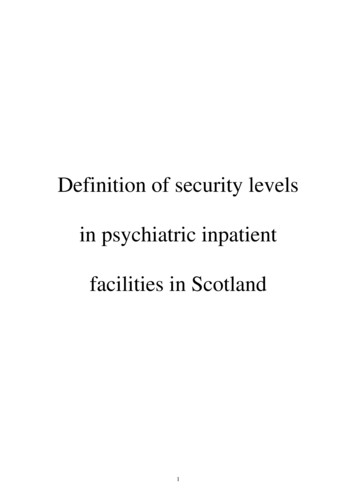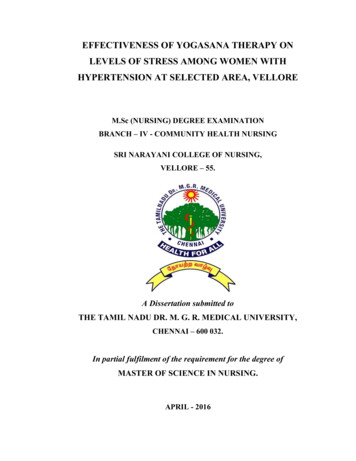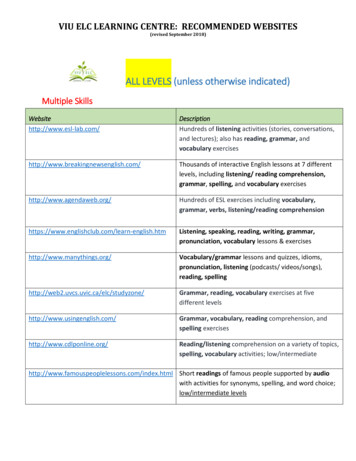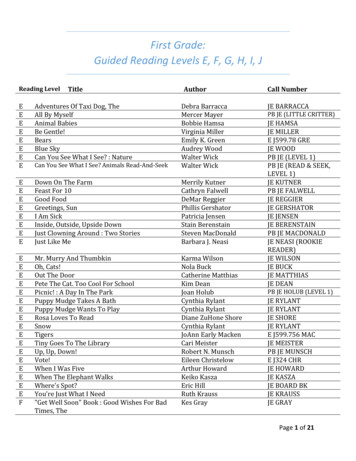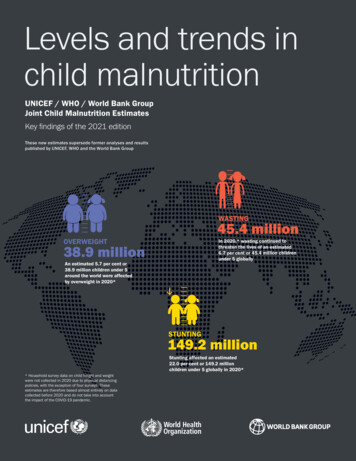
Transcription
Levels and trends inchild malnutritionUNICEF / WHO / World Bank GroupJoint Child Malnutrition EstimatesKey findings of the 2021 editionThese new estimates supersede former analyses and resultspublished by UNICEF, WHO and the World Bank GroupWASTING45.4 millionOVERWEIGHTIn 2020,* wasting continued tothreaten the lives of an estimated6.7 per cent or 45.4 million childrenunder 5 globally38.9 millionAn estimated 5.7 per cent or38.9 million children under 5around the world were affectedby overweight in 2020*STUNTING149.2 millionStunting affected an estimated22.0 per cent or 149.2 millionchildren under 5 globally in 2020** Household survey data on child height and weightwere not collected in 2020 due to physical distancingpolicies, with the exception of four surveys. Theseestimates are therefore based almost entirely on datacollected before 2020 and do not take into accountthe impact of the COVID-19 pandemic.UNICEF/WHO/World Bank Group – Joint Child Malnutrition Estimates 2021 edition1
INTRODUCTIONTOWARDS A FUTURE WITHOUT MALNUTRITIONFOR EVERY CHILDGood nutrition sets children on the pathto survive and thrive. Well-nourishedchildren grow, develop, learn, play,participate and contribute – whilemalnutrition robs children of theirfull potential, with consequences forchildren, nations and the world.Stunting is the devastating result of poornutrition in-utero and early childhood.Children suffering from stunting may neverattain their full possible height and theirbrains may never develop to their fullcognitive potential. These children begintheir lives at a marked disadvantage:they face learning difficulties in school,earn less as adults, and face barriersto participation in their communities.Globally, 149.2 million children under 5suffered from stunting in 2020.* Thesenumbers may increase substantially dueto constraints in accessing nutritiousdiets and essential nutrition servicesduring the COVID-19 pandemic, with thefull impact on stunting possibly takingyears to manifest.Wasting in children is the life-threateningresult of poor nutrient intake and/ordisease. Children suffering from wastinghave weakened immunity, are susceptibleto long-term developmental delaysand face an increased risk of death,particularly when wasting is severe. Thesechildren require urgent treatment and careto survive. In 2020,* 45.4 million childrenunder 5 were affected by wasting, ofwhich 13.6 million were severely wasted.The impact of COVID-19 has likelyexacerbated these figures, and couldmean that 15 per cent or 1.15 times morechildren were affected by wasting in 2020than estimated1 due to deteriorations inhousehold wealth and disruptions to theavailability and affordability of nutritiousfood and essential nutrition services.Childhood overweight occurs whenchildren’s caloric intake from foodand beverages exceeds their energyrequirements. It is shaped by industrymarketing and greater access toprocessed foods, along with inadequatelevels of physical activity, which canincrease children’s risk of obesity anddiet-related noncommunicable diseaseslater in life. There are now 38.9 million*children under 5 with overweight globally,an increase of nearly 6 million since2000. Childhood overweight may alsobe negatively impacted by COVID-19,especially where fresh, nutritious food hasbeen replaced by processed, unhealthyfood, and where movement restrictionshave constrained opportunities forphysical activity for extended periods oftime.The Joint Malnutrition Estimates (JME)published in April 2021 reveal insufficientprogress to reach the World HealthAssembly (WHA) targets set for 2025and the Sustainable Development Goals(SDGs) set for 2030 (see page 25).2 Thelatest analysis indicates that only onequarter of all countries are ‘on track’ tohalve the number of children affected bystunting by 2030, with an assessmentof progress to date not being possiblefor another quarter of countries. Evenfewer countries are expected to achievethe 2030 target of 3 per cent prevalencefor overweight, with just 1 in 6 countriesconsidered ‘on track’. Further, anassessment of progress towards thewasting target is not possible for nearlyhalf of countries.More intensive efforts will be requiredif the world is to achieve global targetsof reducing the number of children withstunting to 104 million by 2025 and to 87million by 2030. Meanwhile, achieving theoverweight goal would require a reversalof the current trajectory.Although malnutrition can manifest inmultiple ways, the path to prevention isvirtually identical: adequate maternalnutrition before and during pregnancyand while breastfeeding; optimalbreastfeeding in the first two years of life;nutritious, diverse and safe foods in earlychildhood; and a healthy environment,including access to basic health, water,hygiene and sanitation services andopportunities for safe physical activity.Many of these vital pathways to goodnutrition are under threat – including dueto the COVID-19 pandemic – and have thepotential to undermine progress towardsending malnutrition in all its forms. Asthe world responds to and recovers fromthe pandemic, urgent action is criticalto protect maternal and child nutrition –especially in the most affected regions– and secure a future where the right tonutrition is a reality for every child.NEW – JME country estimatesThis key findings report for the2021 edition of the JME presentscountry level data for the first time.This is because a new countrylevel model has been developedto generate the country, regionaland global estimates for stuntingand overweight (see page 26).Additional work is ongoing toupdate methods for wasting andsevere wasting; as such, theestimates presented for these twoconditions are based on methodsapplied for previous editions ofthe JME.* Household survey data on child height and weight were not collected in 2020 due to physical distancing policies, with the exception of four surveys. These estimates are therefore based almost entirely on data collected before 2020 and do nottake into account the impact of the COVID-19 pandemic. However, one of the covariates used in the country stunting and overweight models takes the impact of COVID-19 partially into account (see page 3).2UNICEF/WHO/World Bank Group – Joint Child Malnutrition Estimates 2021 edition
COVID -19COVID-19 and the Joint Child Malnutrition EstimatesThe Joint MalnutritionEstimates for the year2020 do not fully accountfor the impact of theCOVID-19 pandemic.Household survey dataon child height, weight and age – used toreport on the JME indicators of stunting,wasting, severe wasting and overweightamong children under 5 years of age –were not collected in 2020 due to physicaldistancing measures, with the exceptionof four surveys. This means that theestimates are based almost entirely ondata collected before 2020. One of thecovariates used in the country models forstunting and overweight takes the impactof COVID-19 partially into account, but isnot expected to capture the full extent ofthe pandemic’s influence on malnutritionin 2020.The pandemic is expected to exacerbateall forms of malnutrition due todeteriorations in household wealth;constraints in the availability andaffordability of nutritious food; disruptionsin essential nutrition services; and limitedopportunities for physical activity.The impact of the pandemic on stuntingwill likely unfold gradually, and may persistfor years after COVID-19 is eradicated andeconomies recover. Given that stuntingis the result of chronic or recurrentmalnutrition, it will be influenced by howlong these pandemic-related shocks tothe economy, food systems and healthsystems persist. Maternal malnutritionexperienced during the pandemic canalso affect stunting by increasing therisk of low birthweight, a key predictorof impaired linear growth.3 Therefore,increased stunting prevalence may beapparent among children born duringthe first year of the pandemic before it isnoticed in the entire under-five populationthat is used to monitor this indicator.Wasting and severe wasting,characterized by a loss of muscle andfat mass, can develop rapidly in theface of poor nutrient intake and/ordisease. These conditions are expectedto be most impacted by COVID-19 in theshort-term and the prevalence-basedestimates presented in this report for2020 may in fact be around 15 percent or 1.15 times higher than what isreported.1 Without representative dataon wasting from countries during thepandemic, only modelled predictions arepossible. Because losses in muscle andfat mass can be reversed rapidly oncethe pandemic subsides and large-scaledata collection on child weight and heightresumes, there may be no evidenceremaining of how wasting prevalencewas affected over the course of thepandemic. Among children who surviveepisodes of wasting during the pandemic,linear growth is likely to be affected;this means that some of the pandemic’senduring impact on stunting may beattributable to prolonged and recurrentepisodes of wasting.The pandemic may also lead to increasesin childhood overweight, especially insettings where food choices and physicalactivity have been negatively influencedby COVID-19 mitigation strategies. Theimpact on overweight may persist throughthe lifetime of those affected, with poordietary and physical activity habits(shaped by restrictions during COVID-19)that continue through adolescenceand adulthood. While data are limited,deteriorations in children’s diet qualityduring the pandemic have beenobserved. In one country, decreases inphysical activity during the pandemicwere reported for 28 per cent of childrenaged 3 to 5 years, while increases insweet snack food consumption werereported for 19 per cent of children.4Forms of malnutrition** highlighted in this key findings reportStunting refers to a child who is too short forhis or her age. Children affected by stuntingcan suffer severe irreversible physical andcognitive damage that accompanies stuntedgrowth. The devastating consequences ofstunting can last a lifetime and even affectthe next generation.StuntingandoverweightWasting refers to a child who is toothin for his or her height. Wasting is theresult of recent rapid weight loss or thefailure to gain weight. A child who ismoderately or severely wasted has anincreased risk of death, but treatmentis possible.StuntingandwastingOverweight refers to a child who is too heavyfor his or her height. This form of malnutritionresults when energy intakes from foodand beverages exceed children’s energyrequirements. Overweight increases the riskof diet-related noncommunicable diseaseslater in life.** Some children suffer from more than one form of malnutrition – such as stuntingand overweight or stunting and wasting. There are currently no joint global orregional estimates for these combined conditions.UNICEF/WHO/World Bank Group – Joint Child Malnutrition Estimates 2021 edition3
.9Stuntinghas declined steadily since 2000 – but0 faster progress is needed to reach020002005 Wasting20102015202020052010will require2015the 2030target.persistsat alarming rates2000and overweighta2020reversal in trajectory if the 2030 target is to be achieved.stuntingwastingoverweight95% confidence 14022.02015Number 5.75.420002005201020152020Percentage of children under 5 affected by stunting,wasting and overweight, global, 52020Number (millions) of children under 5 affected bystunting, wasting and overweight, global, 2000–2020*Source: UNICEF, WHO, World Bank Group Joint Malnutrition Estimates, 2021 edition. See section about regional and global estimates on page 27 for an explanation of why only one time point is presented for wasting on the graphs above.Most children with malnutrition live in Africa and AsiaAsia 53%Africa 41%In 2020,* more than half of allchildren under 5 affected bystunting lived in Asia and two out offive lived in AfricaAsia 70%Africa 27%In 2020,* more than two thirds of allchildren under 5 affected by wastinglived in Asia and more than onequarter lived in AfricaAsia 48%Africa 27%In 2020,* almost half of all childrenunder 5 affected by overweight livedin Asia and more than one quarterlived in Africa*Household survey data on child height and weight were not collected in 2020 due to physical distancing policies, with the exception of four surveys. These estimates are therefore based almost entirely on data collected before 2020 and do nottake into account the impact of the COVID-19 pandemic. However, one of the covariates used in the country stunting and overweight models takes the impact of COVID-19 partially into account (see page 3).4UNICEF/WHO/World Bank Group – Joint Child Malnutrition Estimates 2021 edition
PROGRESS TOWARDS THE SDGsOnly about one quarter of countries are on track to reach the 2030 SDG targets onstunting, wasting and overweightProgress towards thechild malnutritionSDG targets by:Percentage* of childrenPercentage* of countriesGLOBALGLOBAL2% 5%REGIONALAfrican 5425%STUNTING8%25%Asian 4842%Latin America and the Caribbeann 375%Oceania***8%42%n 15Northern America, Europe andAustralia and New Zealand36%n 48WASTING14%Africa36%Asian 4849%21%Latin America and the Caribbeann 378%8%21%6%6%OVERWEIGHTn 5428%25%9%Oceania***n 15Northern America, Europe andAustralia and New Zealandn 48Africa17%n 54Asian 4842%27%9%Latin America and the Caribbeann 37Oceania***17%22%2%n 1532%Northern America, Europe andAustralia and New Zealandn 480On track**Off track–some progress**Off track–no progress**20Off track–worsening**406080100Assessment not possible**Source: UNICEF, WHO, World Bank Group Joint Malnutrition Estimates, 2021 edition. Note: *Percentages may not add up to 100 per cent due to rounding. **See notes on progress assessment categories on pages 16–17.***Oceania excluding Australia and New ZealandThe graphics above show progress towards the SDG2.2 targets on stunting, wasting and overweight. Thegraphics in the left-hand column show progress bypercentage of the global under-five population and thegraphics in the two right-hand columns show progressby percentage of countries (globally and regionally).For the graphics by percentage of the under-fivepopulation (left column), each country was weighted bythe under-five population, meaning that more populouscountries contributed more to the percentages ineach progress category than less populous ones. Incontrast, for the graphs in the two columns on the rightside, each country contributes equally towards thepercentages, regardless of its population size.Availability of data to measure progress varies betweenthe assessment by percentage of the population andthe assessment by percentage of countries; it alsovaries by indicator and region. Almost all children live incountries where progress assessment is possible for allthree indicators. Meanwhile, progress by country canonly be assessed for about three quarters of countriesfor the stunting and overweight targets, and for abouthalf of countries for the wasting target.When considering progress by under-five population,nearly 85 per cent of children live in countries showingat least some progress towards the stunting reductiontarget, with only 10 per cent living in countries thatshow no progress or a worsening situation. Thesituation is more concerning for overweight: halfof children live in countries with no progress or aworsening situation. For wasting, nearly one thirdof children live in countries with no progress or aworsening situation.When considering progress by individual countries (atthe global level), progress on stunting and overweightcan be assessed for three quarters of all countries,while progress on wasting is only possible for abouthalf of countries (see notes on JME methodology onpages 26-27). Overall, the greatest progress is beingmade towards the stunting target, with nearly twothirds of countries seeing at least some progress. Incontrast, for overweight, about half of all countrieshave experienced no progress or are worsening.At the regional level, Northern America, Europe andAustralia and New Zealand have the highest proportionof countries for which progress cannot be assessedacross the three indicators. Conversely, Africa has thehighest proportion of countries for which progress canbe assessed for all three indicators. Asia is contributingmost to the global percentage of countries that are‘on track’ to meet the stunting target, with 21 out of48 countries (or 44 per cent) on track; followed byNorthern America, Europe and Australia and NewZealand with 14 out of 48 countries on track; and LatinAmerica and the Caribbean, with 9 of 37 countries ontrack. While all regions have at least some countrieson track to meet the stunting and wasting targets,in Latin America and the Caribbean, all countries forwhich progress for overweight could be assessed showno progress or a worsening situation, and in NorthernAmerica, Europe and Australia and New Zealand,almost all countries for which progress could beassessed (20 out of 21 countries) are not on track.Gaps in the available data in some regions make itchallenging to accurately assess progress towardsglobal targets. Regular data collection (every threeto five years) is therefore critical to monitor andanalyse country, regional and global progress on childmalnutrition going forward.UNICEF/WHO/World Bank Group – Joint Child Malnutrition Estimates 2021 edition5
STUNTINGCOUNTRY TRENDSThe number of countries with very high stunting prevalencehas declined by half since 2000 – from 67 to 33 countriesPercentage of childrenunder 5 affected bystunting, by country,20201Distribution of stuntingprevalence for each countrywith a modelled estimatepresented for 2020.1Percentage of childrenunder 5 affected bystunting, by country,2000Distribution of stuntingprevalence for each countrywith a modelled estimatepresented for 2000. 2.5% (very low)2.5 – 10% (low)10 – 20% (medium)20 – 30% (high) 30% (very high)modelled estimatenot presentedSource: UNICEF, WHO, World Bank Group, Joint Child Malnutrition Estimates, 2021 edition. Note: 1. Household survey data on child height were not collected in 2020 due to physical distancing policies, with the exception of four surveys. Theseestimates are therefore based almost entirely on data collected before 2020 and do not take into account the impact of the COVID-19 pandemic. However, one of the covariates used in the country stunting model takes the impact of COVID-19partially into account (see page 3). These maps are stylized and not to scale; they do not reflect a position by UNICEF, WHO or World Bank Group on the legal status of any country or territory or the delimitation of any frontiers.6UNICEF/WHO/World Bank Group – Joint Child Malnutrition Estimates 2021 edition
Global prevalence 2020: 22.0%Global prevalence 2000: 33.1%Global number affected 2020: 149.2 MGlobal number affected 2000: 203.6 MSTUNTINGREGIONAL TRENDSProgress to reduce stunting has not been equal across regions and sub-regionsTrends in the percentage of children under 5 affected by stunting, by United Nations region/sub-region, 2000 and 1.811.310.06.7EuropeSouth America†Latin Americaand theCaribbean†Caribbean†4.5Central America†Eastern Asia†Central Asia†Western Asia†South-easternAsia†Southern Asia†Asia†Northern Africa†Southern Africa†Western Africa†Eastern Africa†Middle .64.9Oceania16.86.68.64.02.92.93.22.33.2Western Europe13.9Northern Europe10.410Southern Europe15.2Eastern ralia Global†andNewZealandSource: UNICEF, WHO, World Bank Group Joint Malnutrition Estimates, 2021 edition. Note: 1.Household survey data on child height were not collected in
especially in the most affected regions – and secure a future where the right to nutrition is a reality for every child. INTRODUCTION TOWARDS A FUTURE WITHOUT MALNUTRITION FOR EVERY CHILD NEW – JME country estimates This key findings report for the 2021 edition of the JME presents country level data for the first time.
